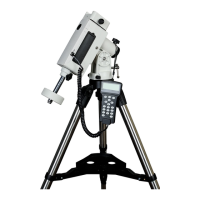9
After attaching an OTA and accessories to the mount, balance the mount in both R.A. and DEC to
ensure minimum stress on the mount.
CAUTION: The telescope may swing when the R.A. or
DEC clutch is released. Always hold on to the OTA
before you release the clutch to prevent it from swinging.
It can cause personal injury or damage to the equipment.
Balance the mount in R.A. axis
Release the R.A. Clutch and rotate the R.A. axis to
place the DEC axis in the horizontal position. The OTA can
be on either side. If the DEC axis stays in the horizontal
position, it means the R.A. axis is balanced. Otherwise, you
may adjust the length of CW shaft, or install and adjust CW
position to balance the mount in R.A. axis. Remember to
install the CW Safety Lock and tighten the CW Locking Screw,
if a CW is installed.
Balance the mount in DEC. axis
Balance in DEC axis is not that critical since the maximum payload is only 11 lbs. Release the DEC
Clutch and if the OTA does not rotate along the DEC axis, it is OK. Tighten the DEC Clutch again.
Adjust the Mount to Zero Position
The Zero Position is the position where the counterweight shaft points to ground, telescope is at the
highest position with its axis parallel to the polar axis and the telescope is pointing to the Celestial Pole.
Loosen the DEC and R.A. Clutches to adjust the mount to the Zero Position by align three marks located on
DEC unit, R.A. unit and mount, respectively. Tighten the screws after adjustment. Make sure the hand
controller is also at the zero position, which can be ensured by turn the mount power off and on again.
Figure 13. Zero Position
Figure 12. R.A. and DEC cluthes
DEC clutch screw
R.A. clutch screw

